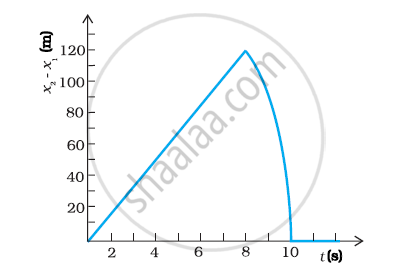Advertisements
Advertisements
Question
Consider the situation of the previous problem. The man has to reach the other shore at the point directly opposite to his starting point. If he reaches the other shore somewhere else, he has to walk down to this point. Find the minimum distance that he has to walk.
Solution
Given:
Width of the river = 500 m
Rate of flow of the river = 5 km/h
Swimmer's speed with respect to water = 3 km/h
As per the question, the man has to reach the other shore at the point directly opposite to his starting point.

Horizontal distance is BD for the resultant velocity vr.
x-component of the resultant velocity, R = 5 - 3 cos θ
Vertical component of velocity = 3 sin θ km/h
\[\text{ Time } = \frac{\text{ Distance } }{\text{ Velocity } } = \frac{0 . 5}{3\sin\theta} h\]
This is the same as the horizontal component of velocity.
Thus, we have:
\[BD = \left( 5 - 3 \cos \theta \right) \left( \frac{0 . 5}{3\sin \theta} \right)\]
\[ = \frac{5 - 3 \cos \theta}{6 \sin \theta}\]
For H (horizontal distance) to be minimum,
⇒ −30 cos θ = 18
\[\Rightarrow \cos \theta = - \frac{18}{30} = - \frac{3}{5}\]
\[\text{ Negative sign shows that } \theta \text{ lies in the 2nd Quadrant .} \]
\[ \text{ And }, \]
\[\sin \theta = \sqrt{1 - \cos^2 \theta } = \frac{4}{5}\]
\[ \therefore H = \frac{5 - 3 \cos \theta}{6 \sin \theta}\]
\[ = \frac{5 - 3\left( \frac{3}{5} \right)}{6 \times \frac{4}{5}} = \frac{25 - 9}{24}\]
\[ = \frac{16}{24} = \frac{2}{3} \text{ km }\]
APPEARS IN
RELATED QUESTIONS
A player throws a ball upwards with an initial speed of 29.4 m s–1.
- What is the direction of acceleration during the upward motion of the ball?
- What are the velocity and acceleration of the ball at the highest point of its motion?
- Choose the x = 0 m and t = 0 s to be the location and time of the ball at its highest point, vertically downward direction to be the positive direction of x-axis, and give the signs of position, velocity and acceleration of the ball during its upward and downward motion.
- To what height does the ball rise and after how long does the ball return to the player’s hands? (Take g = 9.8 m s–2 and neglect air resistance).
Two stones are thrown up simultaneously from the edge of a cliff 200 m high with initial speeds of 15 m/s and 30 m/s. Verify that the graph shown in Fig. 3.27 correctly represents the time variation of the relative position of the second stone with respect to the first. Neglect air resistance and assume that the stones do not rebound after hitting the ground. Take g = 10 m/s2. Give the equations for the linear and curved parts of the plot.

The velocity of a particle is towards west at an instant. Its acceleration is not towards west, not towards east, not towards north and towards south. Give an example of this type of motion .
A particle starting from rest moves with constant acceleration. If it takes 5.0 s to reach the speed 18.0 km/h find the distance travelled by the particle during this period.
A ball is projected vertically upward with a speed of 50 m/s. Find the maximum height.
A ball is projected vertically upward with a speed of 50 m/s. Find the time to reach the maximum height .
A ball is dropped from a balloon going up at a speed of 7 m/s. If the balloon was at a height 60 m at the time of dropping the ball, how long will the ball take in reaching the ground?
A stone is thrown vertically upward with a speed of 28 m/s. Find the maximum height reached by the stone.
A stone is thrown vertically upward with a speed of 28 m/s.Find its velocity one second before it reaches the maximum height.
A ball is thrown at a speed of 40 m/s at an angle of 60° with the horizontal. Find the maximum height reached .
In a soccer practice session the football is kept at the centre of the filed 40 yards from the 10 ft high goalposts. A goal is attempted by kicking the football at a speed of 64 ft/s at an angle of 45° to the horizontal. Will the ball reach the goal post?
A person is standing on a truck moving with a constant velocity of 14.7 m/s on a horizontal road. The man throws a ball in such a way that it returns to the truck after the truck has moved 58.8 m. Find the speed and the angle of projection as seen from the road.
A river 400 m wide is flowing at a rate of 2.0 m/s. A boat is sailing at a velocity of 10 m/s with respect to the water, in a direction perpendicular to the river. Find the time taken by the boat to reach the opposite bank.
A swimmer wishes to cross a 500 m wide river flowing at 5 km/h. His speed with respect to water is 3 km/h. Find the shortest possible time to cross the river.
Suppose A and B in the previous problem change their positions in such a way that the line joining them becomes perpendicular to the direction of wind while maintaining the separation x. What will be the time B finds between seeing and hearing the drum beating by A?
Six particles situated at the corner of a regular hexagon of side a move at a constant speed v. Each particle maintains a direction towards the particle at the next corner. Calculate the time the particles will take to meet each other.
A man is standing on top of a building 100 m high. He throws two balls vertically, one at t = 0 and other after a time interval (less than 2 seconds). The later ball is thrown at a velocity of half the first. The vertical gap between first and second ball is +15 m at t = 2 s. The gap is found to remain constant. Calculate the velocity with which the balls were thrown and the exact time interval between their throw.
